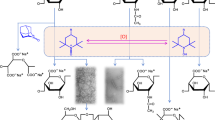Abstract
Catalytic oxidation using N-oxyl radicals in water at pH 10 was applied to wood cellulose to determine the influence of different N-oxyl radical chemical structures on the reaction kinetics and structures of oxidized celluloses. 2,2,6,6-Tetramethylpiperidine-1-oxyl (TEMPO), 2-azaadamantane N-oxyl (AZADO), 1-methyl-AZADO (1-Me-AZADO), 9-azanoradamantane N-oxyl (Nor-AZADO), and 1,5-dimethyl-9-azanoradamantane N-oxyl (DMN-AZADO) were used as oxidation catalysts in a NaBr/NaClO system in water at room temperature and pH 10. The reaction time required for complete oxidation of wood cellulose by 5 mmol/g of NaClO using AZADO, 1-Me-AZADO, or Nor-AZADO was less than 20 min, while DMN-AZADO and TEMPO required 70 min and 120 min, respectively. The sodium carboxylate contents of the oxidized celluloses prepared using TEMPO and DMN-AZADO were 1.41 and 1.45 mmol/g, respectively, which were higher than those of oxidized celluloses prepared using other AZADO derivatives. The original cellulose I crystal structure, crystallinity, and crystal size of wood cellulose were mostly maintained in all oxidized celluloses, with oxidation selectively occurring at C6–OH groups on the crystalline cellulose microfibril surfaces. Oxidized celluloses prepared using DMN-AZADO and post-reduced with NaBH4 showed high carboxylate contents of ~ 1.41 mmol/g and the heist viscosity-average degrees of polymerization of ~ 800.
Graphical abstract









Similar content being viewed by others
References
Battista QA (1950) Hydrolysis and crystallization of cellulose. Ind Eng Chem 42:502–507
Coseri S (2017) Cellulose: to depolymerize… or not to? Biotechnol Adv 35:251–266
de Nooy AEJ, Besemer AC, van Bekkum H (1995) Highly selective nitroxyl radical-mediated oxidation of primary alcohol groups in water-soluble glucans. Carbohydr Res 269:89–98
Doi R, Shibuya M, Murayama T, Yamamoto Y, Iwabuchi Y (2015) Development of an azanoradamantane-type nitroxyl radical catalyst for class-selective oxidation of alcohols. J Org Chem 80:401–413
Einfeldt L, Günther W, Klemm D, Heublein B (2005) Peracetylated cellulose: end group modification and structural analysis by means of 1H-NMR spectroscopy. Cellulose 12:15–24
Funahashi R, Ono Y, Tanaka R, Yokoi M, Daido K, Inamochi T, Saito T, Horikawa Y, Isogai A (2018) Changes in the degree of polymerization of wood celluloses during dilute acid hydrolysis and TEMPO-mediated oxidation: formation mechanism of disordered regions along each cellulose microfibril. Int J Biol Macromol 109:914–920
Håkansson H, Ahlgren P (2005) Acid hydrolysis of some industrial pulps: effect of hydrolysis conditions and raw material. Cellulose 12:177–183
Hayashi M, Sasano Y, Nagasawa S (2011) 9-Azanoradamantane N-oxyl (Nor-AZADO): a highly active organocatalyst for alcohol oxidation. Chem Pharm Bull 59:1570–1573
Hirota M, Furihata K, Saito T, Kawada T, Isogai A (2010) Glucose/glucuronic acid alternating co-polysaccharides prepared from TEMPO-oxidized native celluloses by surface peeling. Angew Chem Int Ed 49:7670–7672
Horikawa Y, Shimizu M, Saito T, Isogai A, Imai T, Sugiyama J (2018) Influence of drying of chara cellulose on length/length distribution of microfibrils after acid hydrolysis. Int J Biol Macromol 109:569–575
Inamochi T, FunahashiR NY, Saito T, Isogai A (2017) Effect of coexisting salt on TEMPO-mediated oxidation of wood cellulose for preparation of nanocellulose. Cellulose 24:4097–4101
Isogai A (2013) Wood nanocelluloses: fundamentals and applications as new bio-based nanomaterials. J Wood Sci 59:449–459
Isogai A, Bergström L (2018) Preparation of cellulose nanofibers using green and sustainable chemistry. Curr Opin Green Sustain Chem 12:15–21
Isogai A, Saito T, Fukuzumi H (2011) TEMPO-oxidized cellulose nanofibers. Nanoscale 3:71–85
Isogai A, Hänninen T, Fujisawa S, Saito T (2018) Review: catalytic oxidation of cellulose with nitroxyl radicals under aqueous conditions. Prog Polym Sci 86:122–148
Iwabuchi Y (2008) Exploration and exploitation of synthetic use of oxoammonium ions in alcohol oxidation. J Synth Org Chem Jpn 66:1076–1084
Iwabuchi Y (2013) Discovery and exploitation of AZADO: the highly active catalyst for alcohol oxidation. Chem Pharm Bull 61:1197–1213
Iwamoto S, Kai W, Isogai T, Saito T, Isogai A, Iwata T (2010) Comparison study of TEMPO-analogous compounds on oxidation efficiency of wood cellulose for preparation of cellulose nanofibrils. Polym Degrad Stab 95:1394–1398
Potthast A, Schiehser S, Rosenau T (2009) Oxidative modifications of cellulose in the periodate system—reduction and beta-elimination reactions. Holzforschung 63:12–17
Saito T, Nishiyama Y, Putaux JL, Vignon M, Isogai A (2006) Homogeneous suspensions of individualized microfibrils from TEMPO-catalyzed oxidation of native cellulose. Biomacromolecules 7:1687–1691
Saito T, Kimura S, Nishiyama Y, Isogai A (2007) Cellulose nanofibers prepared by TEMPO-mediated oxidation of native cellulose. Biomacromolecules 8:2485–2491
Sang X, Qin C, Tong Z, Kong S, Jia Z, Wan G, Liu X (2017) Mechanism and kinetics studies of carboxyl group formation on the surface of cellulose fiber in a TEMPO-mediated system. Cellulose 24:2415–2425
Shibata I, Isogai A (2003) Depolymerization of cellouronic acid during TEMPO-mediated oxidation. Cellulose 10:151–158
Shibuya M, Tomizawa M, Suzuki I, Iwabuchi Y (2006) 2-Azaadamantane N-oxyl (AZADO) and 1-Me-AZADO: highly efficient organocatalysts for oxidation of alcohols. J Am Chem Soc 128:8412–8413
Shinoda R, Saito T, Okita Y, Isogai A (2012) Relationship between length and degree of polymerization of TEMPO-oxidized cellulose nanofibrils. Biomacromolecules 13:842–849
Takaichi S, Isogai A (2013) Oxidation of wood cellulose using 2-azaadamantane N-oxyl (AZADO) or 1-methyl-AZADO catalyst in NaBr/NaClO system. Cellulose 20:1979–1988
Tanaka R, Saito T, Isogai A (2012) Cellulose nanofibrils prepared from softwood cellulose by TEMPO/NaClO/NaClO2 systems in water at pH 4.8 or 6.8. Int J Biol Macromol 51:228–234
Zhou Y, Saito T, Bergström L, Isogai A (2018) Acid-free preparation of cellulose nanocrystals by TEMPO oxidation and subsequent cavitation. Biomacromolecules 19:633–639
Acknowledgments
This research was supported by Core Research for Evolutional Science and Technology (CREST, Grant Number JPMJCR13B2) of the Japan Science and Technology Agency (JST). We thank Simon Partridge, Ph.D., from Edanz Group (www.edanzediting.com/ac) for editing a draft of this manuscript.
Author information
Authors and Affiliations
Corresponding author
Electronic supplementary material
Below is the link to the electronic supplementary material.
Rights and permissions
About this article
Cite this article
Hondo, H., Saito, T. & Isogai, A. Preparation of oxidized celluloses in a NaBr/NaClO system using 2-azaadamantane N-oxyl (AZADO) derivatives in water at pH 10. Cellulose 26, 1479–1487 (2019). https://doi.org/10.1007/s10570-018-2177-5
Received:
Accepted:
Published:
Issue Date:
DOI: https://doi.org/10.1007/s10570-018-2177-5




